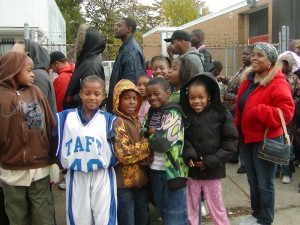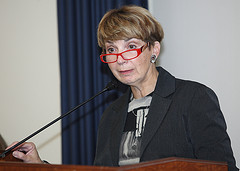From: Michigan League for Human Services
Fri, Aug 31, 2012 at 9:24 AM
Labor Day Report: Michigan’s lower unemployment rate masks deeper issues
State has highest rate in the Midwest for working families living in poverty
Michigan’s unemployment rate has dropped dramatically since it hit 14.2 percent in August 2009 and the state is no longer No. 1 in unemployment, but the lower rate masks serious problems with employment in Michigan, a Labor Day report concludes.

Detroit children and parents wait in line for free winter coats provided by Moorish Science Temple of America.
In fact, Michigan has more “lost workers,’’ than unemployed workers. Lost workers are those who have left the workforce and are not counted in the employment statistics as either unemployed or employed. In addition, Michigan has the biggest share in the Midwest of working families who live in poverty, despite holding down jobs.
The Labor Day Report, Michigan Falling Unemployment Rate Masks Serious Concerns , was released by the Michigan League for Human Services. (Click on MLHS Labor Day Report for full report.)
“Thankfully we no longer are known as the state with the highest unemployment in the country, but that doesn’t mean our workers are all doing well,’’ said Gilda Z. Jacobs, president & CEO of the Michigan League for Human Services. “It’s still important that we address policies that will offer workers a career ladder and the ability to cover their basic needs.’’
Michigan has a shrinking labor force with 4.66 million workers, down from 5.12 million in January 2001. Slightly more than 60 percent of the state’s adults were in the labor force in 2011, the lowest on record, dropping from nearly 69 percent in 2000, the highest on record.
Of Michigan’s working families, one in every 10 was living in poverty in 2011, the highest percent in the Midwest. Poverty is about $18,000 a year or less for a family of three and $23,000 a year or less for a family of four.
Other findings:
- More than one in every four of Michigan’s workers are in low wage jobs (earning $10.39 per hour or less) – the highest share in the Midwest except for Illinois.
- Michigan’s employment to population ratio is at its lowest since 1982, the state’s worst recession.
- Black workers suffered the most over the decade with 60 percent of black adults working in 2000, falling to just 42 percent in 2011. [The ratio of Black employment to population fell further, by 18.8 percent.]
- Of the seven occupations in the state with the highest number of workers, five have a median wage that will not lift a family of four out of poverty, while three will just barely keep a family of three out of poverty.
- Michigan men earn $3.84 an hour more than Michigan women, the biggest gap in the Midwest save for Indiana.
“This report reinforces the fact that education makes a difference in the lives of workers. A worker with an associate degree earns $3 more an hour on average than someone with only a high school diploma,’’ Jacobs said.
About 37 percent of working age adults holds an associate degree or higher, though there are stark disparities based on race. Only 22 percent of Hispanic workers and 23 percent of black workers have an associate degree or higher, compared with 39 percent of white workers.
MLHS Contact: Judy Putnam at (517) 487-5436 jputnam@milhs.orgc
VOD: Dr. Boyce Watkins on Black unemployment rate nationally: http://newsone.com/1510935/black-unemployment-rate/







